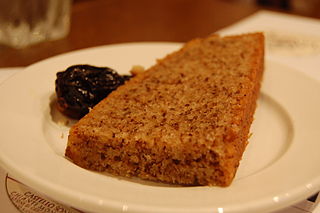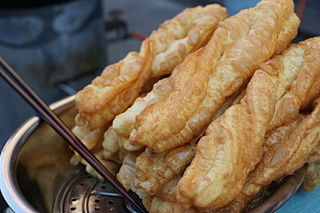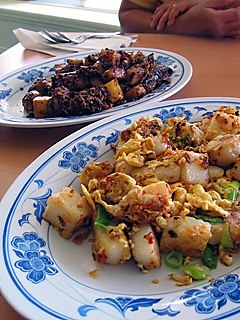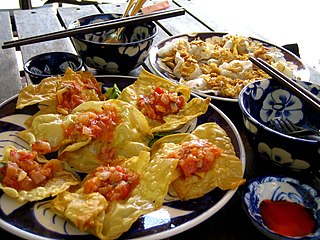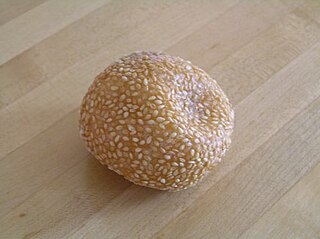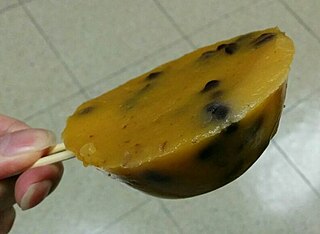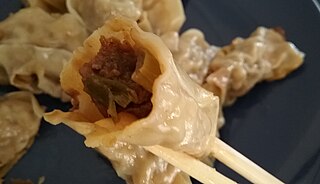 | |
| Course | dim sum |
|---|---|
| Place of origin | Guangdong, China |
| Region or state | Cantonese-speaking areas |
| Main ingredients | shredded Chinese water chestnut |
| Water chestnut cake | |||||||||||||||||||||
| Traditional Chinese | 馬蹄糕 | ||||||||||||||||||||
|---|---|---|---|---|---|---|---|---|---|---|---|---|---|---|---|---|---|---|---|---|---|
| Simplified Chinese | 马蹄糕 | ||||||||||||||||||||
| Cantonese Yale | máhtài gōu | ||||||||||||||||||||
| Hanyu Pinyin | mǎtí gāo | ||||||||||||||||||||
| Literal meaning | horsehoof cake | ||||||||||||||||||||
| |||||||||||||||||||||
Water chestnut cake (traditional Chinese :馬蹄糕; simplified Chinese :马蹄糕; Cantonese Yale :máhtài gōu) is a sweet Cantonese dim sum dish made of shredded Chinese water chestnut. [1] When served during dim sum , the cake is usually cut into square-shaped slices and pan-fried before serving. The cake is soft, but holds its shape after the frying. Sometimes the cake is made with chopped water chestnuts embedded into each square piece with the vegetable being visible. One of the main trademark characteristics of the dish is its translucent appearance.

Traditional Chinese characters are Chinese characters in any character set that does not contain newly created characters or character substitutions performed after 1946. They are most commonly the characters in the standardized character sets of Taiwan, of Hong Kong and Macau, and in the Kangxi Dictionary. The modern shapes of traditional Chinese characters first appeared with the emergence of the clerical script during the Han Dynasty, and have been more or less stable since the 5th century.

Simplified Chinese characters are standardized Chinese characters prescribed in the Table of General Standard Chinese Characters for use in mainland China. Along with traditional Chinese characters, they are one of the two standard character sets of the contemporary Chinese written language. The government of the People's Republic of China in mainland China has promoted them for use in printing since the 1950s and 1960s to encourage literacy. They are officially used in the People's Republic of China and Singapore.
The Yale romanization of Cantonese was developed by Gerard P. Kok for his and Parker Po-fei Huang's textbook Speak Cantonese initially circulated in looseleaf form in 1952 but later published in 1958. Unlike the Yale romanization of Mandarin, it is still widely used in books and dictionaries, especially for foreign learners of Cantonese. It shares some similarities with Hanyu Pinyin in that unvoiced, unaspirated consonants are represented by letters traditionally used in English and most other European languages to represent voiced sounds. For example, is represented as b in Yale, whereas its aspirated counterpart, is represented as p. Students attending The Chinese University of Hong Kong's New-Asia Yale-in-China Chinese Language Center are taught using Yale romanization.
It is one of the standard dishes found in the dim sum cuisine of Hong Kong, and is also available in select overseas Chinatown restaurants.

Dim sum is a style of Chinese cuisine prepared as small bite-sized portions of food served in small steamer baskets or on a small plate. Dim sum dishes are usually served with tea and together form a full tea brunch. Due to the Cantonese tradition of enjoying tea with this cuisine, yum cha (飲茶), which means "drink tea" in Cantonese, is also synonymous with dim sum. Dim sum traditionally are served as fully cooked, ready-to-serve dishes. In some Cantonese teahouses, carts with dim sum are served around the restaurant.

Hong Kong, officially the Hong Kong Special Administrative Region of the People's Republic of China and commonly abbreviated as HK, is a special administrative region of the People's Republic of China on the eastern side of the Pearl River estuary in southern China. With over 7.4 million people of various nationalities in a 1,104-square-kilometre (426 sq mi) territory, Hong Kong is the world's fourth most densely populated region.

A Chinatown is an ethnic enclave of Chinese people located outside mainland China, Hong Kong, Macau or Taiwan, most often in an urban setting. Areas known as "Chinatown" exist throughout the world, including Europe, North America, South America, Asia, Africa, Australia and Zealandia.
